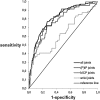Assessment of disease activity in patients with rheumatoid arthritis using optical spectral transmission measurements, a non-invasive imaging technique
- PMID: 26452538
- PMCID: PMC4789697
- DOI: 10.1136/annrheumdis-2015-207315
Assessment of disease activity in patients with rheumatoid arthritis using optical spectral transmission measurements, a non-invasive imaging technique
Abstract
Objectives: In rheumatoid arthritis (RA), treat-to-target strategies require instruments for valid detection of joint inflammation. Therefore, imaging modalities are increasingly used in clinical practice. Optical spectral transmission (OST) measurements are non-invasive and fast and may therefore have benefits over existing imaging modalities. We tested whether OST could measure disease activity validly in patients with RA.
Methods: In 59 patients with RA and 10 patients with arthralgia, OST, joint counts, Disease Activity Score (DAS) 28 and ultrasonography (US) were performed. Additionally, MRI was performed in patients with DAS28<2.6. We developed and validated within the same cohort an algorithm for detection of joint inflammation by OST with US as reference.
Results: At the joint level, OST and US performed similarly inproximal interphalangeal-joints (area under the receiver-operating curve (AUC) of 0.79, p<0.0001) andmetacarpophalangeal joints (AUC 0.78, p<0.0001). Performance was less similar in wrists (AUC 0.62, p=0.006). On the patient level, OST correlated moderately with clinical examination (DAS28 r=0.42, p=0.001), and US scores (r=0.64, p<0.0001). Furthermore, in patients with subclinical and low disease activity, there was a correlation between OST and MRI synovitis score (RAMRIS (Rheumatoid Arthritis MRI Scoring) synovitis), r=0.52, p=0.005.
Conclusions: In this pilot study, OST performed moderately in the detection of joint inflammation in patients with RA. Further studies are needed to determine the diagnostic performance in a new cohort of patients with RA.
Keywords: Disease Activity; Magnetic Resonance Imaging; Rheumatoid Arthritis; Synovitis; Ultrasonography.
Published by the BMJ Publishing Group Limited. For permission to use (where not already granted under a licence) please go to http://www.bmj.com/company/products-services/rights-and-licensing/
Figures





References
-
- van Gestel AM, Prevoo ML, van ‘t Hof MA, et al. . Development and validation of the European League Against Rheumatism response criteria for rheumatoid arthritis. Comparison with the preliminary American College of Rheumatology and the World Health Organization/International League Against Rheumatism Criteria. Arthritis Rheum 1996;39:34–40. 10.1002/art.1780390105 - DOI - PubMed
Publication types
MeSH terms
LinkOut - more resources
Full Text Sources
Other Literature Sources

